|
|
|
Sort Order |
|
|
|
Items / Page
|
|
|
|
|
|
|
| Srl | Item |
| 1 |
ID:
142773


|
|
|
|
|
| Summary/Abstract |
The fortieth anniversary of the rise of communist governments in Vietnam, Laos and Cambodia looks different to the Lao compared to how it does for the Vietnamese. 30 April 1975 is undoubtedly a crucial date in Vietnamese history – one that is significant inside and outside of Vietnam. But few people from Laos, either within the country or residing in diaspora communities in the United States, France, Canada, Australia or New Zealand – the main countries where refugees ended up after fleeing across the Mekong River to Thailand from Laos beginning in 1975 – attach much significance to it. However, the year 1975 is another matter altogether. As with Vietnam, the year is important for people from Laos, as 1975 is one of the most significant ‘time markers’ for those on both ends of the political spectrum, including those living inside Laos and outside of the country. It is the same year that Laos dissolved its constitutional monarchy and became the Lao People’s Democratic Republic (Lao PDR). But Laos did not “fall to communism” in the same way as South Vietnam and Cambodia. The fall of the governments in both countries occurred decisively on particular dates in 1975 (30 April and 17 April respectively) when communist forces rode triumphantly into Saigon and Phnom Penh.
|
|
|
|
|
|
|
|
|
|
|
|
|
|
|
|
| 2 |
ID:
157220
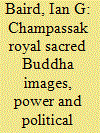

|
|
|
|
|
| Summary/Abstract |
What is the relationship between Buddha images and the legitimization of political power over space? What understandings exist amongst royals concerning regaining spatial power associated with Buddha images? This article considers these questions with a particular focus on the Champassak Royal House, a royal family that was originally spatially constituted through the territorial control it had over present-day southern Laos and some neighbouring areas. To do this, the article draws upon two case studies, one centred on an important Buddha image in the 18th century, the other more contemporary and linked to Buddha images and exiled members of the Champassak Royal House. Buddha images have long played an important role in constituting and defining sacred geographies, and thus political power, in Champassak, as has similarly been the case in other parts of mainland Southeast Asia.
|
|
|
|
|
|
|
|
|
|
|
|
|
|
|
|
| 3 |
ID:
128886


|
|
|
|
|
| Publication |
2013.
|
| Summary/Abstract |
Without much attention to local context, global health policy experiments are being conducted on vulnerable indigenous populations. This article details the history of a development-bank-funded experiment to contract out public health services in Cambodia's north-eastern province of Ratanakiri. The case study highlights the difficulties that flow from improper planning and implementation, as well as the distorting effects that narrowly defined contract performance measures can have on the health of the population as a whole. Progress in global health will not be possible if local context and voices continue to be underappreciated.
|
|
|
|
|
|
|
|
|
|
|
|
|
|
|
|
| 4 |
ID:
131767
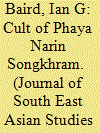

|
|
|
|
|
| Publication |
2014.
|
| Summary/Abstract |
Sociocultural boundaries come in many forms, and crucially, are responsive to power and constantly in flux. This article focuses on the production of space and unmarked sociocultural boundaries linked to spirit mediums in a historically contested area of northeastern Thailand who are possessed by the spirits of Phaya Narin Songkhram - a key 'Lao' military leader of Chao Anou's famous Vientiane revolt against Siam between 1826-28 - and those of his subordinates. Spirit mediums linked to ethnic 'Thai' leaders are also found to the south of this area. Through channeling and performing these historical persons, spirit mediums keep alive and reproduce group memories with space-making implications. This article also shows how the mediums' positioning has shifted over time and varies in relation to contemporary power relations, altering the sociocultural boundaries between ethnic Lao and Thai.
|
|
|
|
|
|
|
|
|
|
|
|
|
|
|
|
| 5 |
ID:
095562
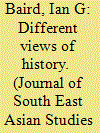

|
|
|
|
|
| Publication |
2010.
|
| Summary/Abstract |
The administrative boundary between Laos and Cambodia is amongst the least studied international borders in Southeast Asia. Since Laos and Cambodia became independent in 1953-54, relatively minor but sustained tensions have characterised border relations. An important reason for disagreements is irredentist feelings. Some ethnic Lao in both Laos and Cambodia believe that part of northeastern Cambodia should be added to Laos, while some ethnic Khmer in Cambodia insist that their border should be extended to include part of southern Laos. Different emphases and framings of history have contributed to irredentism and the development of identities in relation to the border.
|
|
|
|
|
|
|
|
|
|
|
|
|
|
|
|
| 6 |
ID:
105061
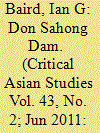

|
|
|
|
|
| Publication |
2011.
|
| Summary/Abstract |
Plans are underway to construct twelve large hydropower projects on the un-dammed lower and middle mainstream Mekong River in Laos, Thailand, and Cambodia. One of the planned projects is a 30-32 meter-high hydroelectric dam with an expected 240 MW installed generating capacity to be built on the Hou Sahong Channel, less than one kilometer north of the Laos-Cambodia border, in the Khone Falls area of Khong District, Champasak Province, southern Laos. The project's objective is to generate revenue by exporting electricity to Thailand or Cambodia. Concerns have been raised about the Don SahongDam(DSD), however. The main ones relate to potential repercussions on aquatic resources, and especially wild-capture fisheries dependent on migratory fish. This article examines the regional implications of the DSD, including possible impacts on food security, nutrition, and poverty alleviation. Fisheries losses in the Mekong Region from the DSD would negatively affect the nutrition of hundreds of thousands or even millions of people, especially in parts of Laos, Cambodia, and Thailand where nutritional standards are already low. Mekong fisheries are integral to food security in the region, and the DSD would make it difficult for governments, especially in Laos and Cambodia, to reach their health-related United Nations Millennium Development Goals and their objectives for reducing poverty.
|
|
|
|
|
|
|
|
|
|
|
|
|
|
|
|
| 7 |
ID:
178624
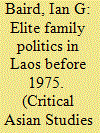

|
|
|
|
|
| Summary/Abstract |
Major General Phasouk S. Rajphakd and Brigadier General Soutchay Vongsavanh were important right-wing military officers in the Royal Lao Army in southern Laos before 1975. However, elite family relations in Laos – especially between prominent families from the north and the south – greatly affected how they acted and interacted over the years. This article considers family relations in Laos during the 1960s and early 1970s. Kinship relations are certainly not determinant of all social or political interactions, as individual agency is also important, but they are often crucial nonetheless. There has been insufficient discussion about how elite family relations played out in Laos during the 1954–1975 period. To partially fill this gap, this article explores how tensions between the House of Champassak in southern Laos and the House of Luang Prabang and the powerful Sananikone family in Vientiane led to disunity amongst non-communist factions in Laos, and eventually contributed to the Pathet Lao takeover of the country in 1975.
|
|
|
|
|
|
|
|
|
|
|
|
|
|
|
|
| 8 |
ID:
165104
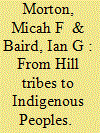

|
|
|
|
|
| Summary/Abstract |
This article presents a chronology of the growth of the concept of Indigeneity in Thailand, analysing the particular ways in which the global Indigenous movement has taken root in the country. In Thailand, transnational support networks and the opening of political associational space played key roles in facilitating the growth of, first, a regional, and later a national Indigenous movement during the 1980s and early 2000s, respectively. Indigenous Peoples in Thailand are asserting their identity by drawing on a new concept of Indigeneity being promoted by the United Nations and other international advocacy organisations that identifies them not only as first peoples, but crucially as colonised or oppressed peoples. Indigenous Peoples in Thailand are further asserting both their cultural distinctiveness and their compatibility with the Thai nation. The Indigenous movement in Thailand differs from movements in Australia, Canada, and the United States where Indigenous Peoples must perform their cultural distinctiveness to maintain political recognition, and in turn are accused of being not different enough when exercising their rights. In Thailand, rather, Indigenous Peoples are accused of being not Thai enough in their efforts to push for any political recognition. While the Thai government denies the relevance of the concept of Indigeneity to Thailand, it is clear that the Indigenous movement in Thailand has grown since the early 2000s. In fact, state policies between the 1950s and early 2000s contributed toward the scaling-up of a pan-Hill tribe identity among the core groups associated with the movement.
|
|
|
|
|
|
|
|
|
|
|
|
|
|
|
|
| 9 |
ID:
133117


|
|
|
|
|
| Publication |
2014.
|
| Summary/Abstract |
The dramatic expansion of large-scale economic land concessions and acquisitions in the Global South has generated considerable concern amongst activists, journalists and academics recently. This has led to the increased prevalence of the term 'global land grabbing', which I argue represents a particular type of meta-narrative. In this article the global land grab meta-narrative is considered in relation to recent land alienation of Indigenous Peoples in the northeastern Cambodia province of Ratanakiri. While land grabbing is certainly a crucial problem, it is insufficient to explain the circumstances in Ratanakiri or in Cambodia more generally as 'global land grabbing'. While foreign capital is associated with land grabbing in Cambodia, there are various other factors that also require consideration. Specifically, the role of Asian money laundering and elite capture requires increased attention. This article contributes to better understanding the particular ways that land dispossession plays out in particular places and contexts.
|
|
|
|
|
|
|
|
|
|
|
|
|
|
|
|
| 10 |
ID:
145850


|
|
|
|
|
| Summary/Abstract |
This introduction presents background information about some of the ways that the concept of indigenous peoples is emerging but is also being contested in Asia. Indeed, many governments in Asia accept that there are indigenous peoples in the world, but claim that the concept does not apply to them due to a relative lack of European settler colonization in the continent. This is why many governments of Asia signed onto the United Nations Declaration on the Rights of Indigenous Peoples (UNDRIP) in 2007, but with the understanding that UNDRIP does not apply to them. This has become known as ‘the salt-water theory’ or the ‘Asian controversy’. This special issue includes five articles that variously consider the ways that the concept of indigeneity is being deployed in various parts of Asia, including Cambodia, Myanmar, and Nepal, and also transnationally between Thailand, Myanmar, China and Laos; and between Cambodia, Vietnam and the United States.
|
|
|
|
|
|
|
|
|
|
|
|
|
|
|
|
| 11 |
ID:
127083
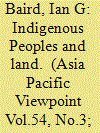

|
|
|
|
|
| Publication |
2013.
|
| Summary/Abstract |
In 2001 a new Land Law was adopted in Cambodia. It was significant because - for the first time - it recognised a new legal category of people, 'Indigenous Peoples' or chuncheat daoem pheak tech in Khmer, and it also introduced the legal concept of communal land rights to Cambodia. Indigenous Peoples are not mentioned in the 1993 constitution of Cambodia or any legislation pre-dating the 2001 Land Law. However, Cambodia's 2002 Forestry Law also followed the trend by recognising 'Indigenous Peoples'. These laws have been both symbolically and practically important, as they have provided government-mandated legitimacy to Indigenous identities and associated land and forest rights, including communal land rights, and have been ontologically significant in dividing Indigenous and non-Indigenous Peoples on legal grounds. Over a decade after the 2001 Land Law was promulgated, this article considers some aspects of its effects. In particular, when compared with the potential for developing communal land rights in Laos, one has to wonder how advantageous it is to adopt Indigenous identities and the types of communal land rights and community forestry rights presently possible in Cambodia.
|
|
|
|
|
|
|
|
|
|
|
|
|
|
|
|
| 12 |
ID:
165103


|
|
|
|
|
| Summary/Abstract |
Only a few decades ago, there was not a country in Asia that recognised the existence of specifically and legally defined ‘Indigenous Peoples’. In recent years, however, that has changed, albeit unevenly. The concept of indigeneity is being increasingly accepted, both by governments and the public, although it remains highly controversial, even in countries where it has made some ground legally. For example, in the region we now frequently refer to as ‘Southeast Asia’, the governments of the Philippines and Cambodia now define particular ethnic groups of people as Indigenous, and are providing these groups with particular rights. In other countries in the region, the concept of Indigenous Peoples is still not legally recognised, but there is increasing acceptance of the concept, or at least recognition of it amongst certain groups. Questions related to the proliferation and contested nature of the concept of Indigenous Peoples were addressed during a multidisciplinary workshop organised by the Center for Southeast Asian Studies at the University of Wisconsin-Madison in March 2015. This special issue of the Journal of Southeast Asian Studies is devoted to considering some of the conceptions of indigeneity in Southeast Asia that brought together a group of scholars and activists from various countries in Asia and the United States for the workshop, which was financially supported through a grant provided by Open Society Foundations.
|
|
|
|
|
|
|
|
|
|
|
|
|
|
|
|
| 13 |
ID:
122907
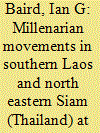

|
|
|
|
|
| Publication |
2013.
|
| Summary/Abstract |
Interrelated holy men millenarian movements destabilized southern Laos and North East Siam (Isan) at the turn of the twentieth century. In contrast to those who have interpreted these uprisings as purely anti-state, the author presents evidence to suggest that Champassak royals played crucial roles in supporting the revolts, even to the extent of masterminding rebellions against both the French and the Siamese in order to enhance their own power. The findings of this research illustrate the varying power structures that existed within lowland states in mainland South East Asia at the beginning of the twentieth century, a point that has implications with regard to James Scott's (2009) arguments in The Art of Not Being Governed: An Anarchist History of Upland Southeast Asia.
|
|
|
|
|
|
|
|
|
|
|
|
|
|
|
|
| 14 |
ID:
144917
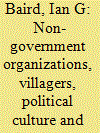

|
|
|
|
|
| Summary/Abstract |
The Lower Sesan 2 (LS2) Hydropower Project in northeastern Cambodia is presently under construction. As the largest dam to ever be built in Cambodia, it is expected to cause serious and widespread environmental and social impacts. This article analyzes, on the one hand, the relationships between Cambodian non-government organizations (NGOs) and villagers who will be negatively impacted by LS2, and on the other, NGO relations with the Cambodian state. While development actors frequently attempt to construct particular narratives in order to control development trajectories, this research demonstrates that such attempts can meet with serious resistance from local people, even when facing powerful opponents, including in this case NGOs that prefer to advocate for better resettlement and compensation conditions rather than for the cancellation of projects. Focusing on interactions, positioning, local agency, and the particular political culture of Cambodia, this article highlights the importance of particular types of patronage relations in Cambodia between NGOs and villagers, NGOs and the state, and associated territorialization.
|
|
|
|
|
|
|
|
|
|
|
|
|
|
|
|
| 15 |
ID:
145851
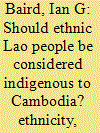

|
|
|
|
|
| Summary/Abstract |
The ethnic Lao are not well-known in Cambodia, despite constituting a substantial but unrecorded population there. Even though the Lao have lived in Cambodia for many generations, they were excluded from being considered ‘indigenous peoples’ when the category was legally introduced to Cambodia through the 2001 land law. Instead, they are not classified as ‘ethnic Lao’, except for the very few who were actually born in Laos. Here, I consider how the politics of identity in Cambodia has separated some highland ethnic minorities from the Lao. Many ethnic Lao in Cambodia quietly disagree with not being classified as indigenous. This contestation represents a similar dynamic to the differences of opinion between the Asian Indigenous Peoples Pact (AIPP) and the peasant organization, La Via Campesina, regarding advocating for indigenous and peasant rights, respectively. My objective is to demonstrate that the politics of indigenous categorization in Cambodia is complicated and fraught.
|
|
|
|
|
|
|
|
|
|
|
|
|
|
|
|
| 16 |
ID:
153002


|
|
|
|
|
| Summary/Abstract |
On 22 May 2014, the Thai military conducted a coup d’état and discarded the previous constitution. In April 2015, a new draft constitution was prepared. Although eventually rejected by the military, it represented an exciting moment for activists, as it recognized the existence of ‘indigenous peoples’ (referred to as chon pheun muang in the draft). This prompted us to conduct interviews in 2015–2016 with people belonging to four different ethnic groups and living mainly in Chiang Mai province, northern Thailand: the Lua, Khon Muang, Hmong, and Lisu, in order to determine their understandings of who should be considered ‘indigenous peoples’, and what rights should they have. The findings indicate that there is considerable variation amongst people regarding the meaning of the term ‘indigenous peoples’; who should be considered indigenous; and what rights those defined as being indigenous should be entitled to.
|
|
|
|
|
|
|
|
|
|
|
|
|
|
|
|
|
|
|
|
|